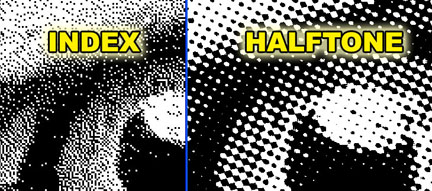

Index Color: This probably is the most confusing of the separation methods. Simulated- process-color separations can be printed on light and dark shirts, and generally are created in Photoshop.

They often are called “tonal” or “channel” separations. They have the look and feel, but the separations are comprised of solid and halftone images of spot colors such as red, yellow, blue, gray, green, brown, black, etc. Simulated-Process Color: This also is known as “fake”process color or “fake CMYK.” Simulated-process-color images have a photorealistic look, but are not printed with CMYK colors. Instead, they are done in Adobe Photoshop. Process-color separations generally are not done in vector-based programs like CorelDRAW or Illustrator. The secret to successful process-color prints is proper separations and good printing. It generally requires better control, with properly tensioned, high-mesh-count screens, and the ability to hold fine halftone dots and print them in register with minimal dot gain (halftone dots get bigger when printed). Faces turn red, dark areas get darker, etc.įor these reasons, process-color printing is not for everyone. If separations aren’t done properly, the images will be muddy and colors can shift. If you used a magnifier when viewing the images, you would see small halftone dots that - when printed - make up most of the colors in a rainbow. All magazine photos and traditional offset/litho paper-printed items use only these four colors. Process Color: Process-color images are comprised of cyan, magenta, yellow and black (CMYK). These separations are done in vector-based graphic programs such as CorelDRAW and Adobe Illustrator.


Spot-color separations and prints generally are used for logos, school designs, clip art, hard-edged graphics, cartoons or other images that have a dark outline. Spot-color images generally have specific solid colors, but also can have small halftone dots for shading. Spot Color: This is the bread and butter of the industry. If the image has gradations, shading or photorealistic elements, those parts of the color separation need to be converted to halftone dots that can be burned onto a screenįollowing are details on types of separations common in the decorated apparel industry. What are color separations, or “seps?” To screen print images with more than one color, each color requires a separate screen.


 0 kommentar(er)
0 kommentar(er)
